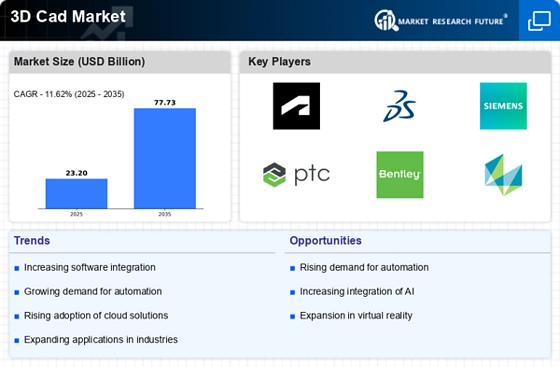Rising Demand for 3D Printing
The increasing adoption of 3D printing technologies is a pivotal driver for the 3D Cad Market Industry. As industries such as aerospace, automotive, and healthcare embrace additive manufacturing, the need for precise 3D CAD models intensifies. According to recent data, the 3D printing market is projected to reach USD 34.8 billion by 2026, indicating a robust growth trajectory. This surge necessitates advanced CAD software that can seamlessly integrate with 3D printing processes, thereby enhancing design accuracy and efficiency. Consequently, the 3D Cad Market Industry is likely to experience heightened demand as manufacturers seek to optimize their design workflows and reduce production costs through innovative CAD solutions.
Increased Focus on Customization
Customization is emerging as a critical driver within the 3D Cad Market Industry. As consumer preferences shift towards personalized products, manufacturers are compelled to adopt CAD solutions that facilitate bespoke design capabilities. This trend is particularly evident in sectors such as fashion, consumer electronics, and furniture, where tailored designs are increasingly sought after. The demand for customized products is projected to grow, with a significant portion of consumers willing to pay a premium for personalized items. Consequently, CAD software that supports flexible design options and rapid prototyping is becoming essential. This shift towards customization is likely to propel the 3D Cad Market Industry forward, as companies strive to meet evolving consumer expectations.
Growing Need for Collaboration Tools
The growing emphasis on collaboration in design processes is a significant driver for the 3D Cad Market Industry. As teams become more geographically dispersed, the demand for cloud-based CAD solutions that facilitate real-time collaboration is on the rise. These tools enable multiple stakeholders to work on a single project simultaneously, enhancing productivity and reducing time-to-market. Recent studies indicate that companies utilizing collaborative design tools experience a 30% increase in project efficiency. This trend is likely to continue, as organizations seek to streamline their workflows and improve communication among team members. Consequently, the 3D Cad Market Industry is expected to expand as more businesses adopt collaborative CAD solutions to enhance their design capabilities.
Integration of IoT in Design Processes
The integration of Internet of Things (IoT) technologies into design processes is reshaping the 3D Cad Market Industry. IoT enables real-time data collection and analysis, allowing designers to create more intelligent and responsive products. This trend is particularly relevant in industries such as smart home technology and automotive, where connectivity is paramount. As IoT adoption continues to rise, the demand for CAD software that can accommodate these technologies is expected to increase. The IoT market is projected to reach USD 1.1 trillion by 2026, indicating a substantial opportunity for the 3D Cad Market Industry to evolve alongside these advancements. This integration not only enhances product functionality but also fosters innovation in design methodologies.
Advancements in Simulation Technologies
Technological advancements in simulation tools are significantly influencing the 3D Cad Market Industry. Enhanced simulation capabilities allow designers to visualize and test their models in virtual environments, thereby reducing the risk of errors in the final product. The integration of real-time simulation features into CAD software is becoming increasingly prevalent, enabling engineers to make informed decisions during the design phase. This trend is underscored by the fact that the simulation software market is expected to grow at a CAGR of 14.5% from 2021 to 2028. As a result, the 3D Cad Market Industry is poised to benefit from the growing emphasis on simulation-driven design processes, which enhance product quality and accelerate time-to-market.


















Leave a Comment